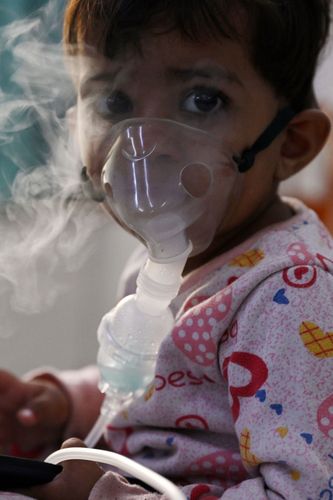Every breath you take, depending on where you take it, is poisonous in varying degrees.
Five years after the country launched its National Clean Air Programme, it is distressing to note that even in cities that have seen the greatest improvement in Air Quality Index (AQI), the air still falls in the ‘moderately polluted’ category. The National AQI describes this bracket as one that “may cause breathing discomfort to people with lung disease such as asthma, and discomfort to people with heart disease, children and older adults”.
Air pollution, despite its ascendancy in public consciousness, remains a partially understood challenge. No, it is not limited to the winter months. No, it does not assume monstrous proportions only in north India. No, it is not an urban curse. And a big no for believing that it only affects lung health.
One of the most alarming impacts of air pollution is on fertility—the ability to conceive a child. This is an effect that transcends individuals and generations, for it can and will lead to disastrous demographic consequences.
A decline in fertility and a global increase in life expectancy equal a rapidly ageing world population, thus precipitating a series of problems such as labour shortage and heightened financial pressure. While multiple factors like more women getting education and entering the workforce, social acceptance of late marriage, overall health condition, body weight, nutrition and choice play a role in fertility, the challenge is to tackle avoidable factors, including pollution, for those who want to have children.
“Fertility is influenced by a complex interplay of genetic, physiological, lifestyle and environmental factors,” said Dr Preeti Rastogi, director, obstetrics and gynaecology at Medanta Hospital, Gurugram. “Pollution represents just one among numerous potential contributors…. The challenge lies in the variability of pollution exposure levels, which depends on factors such as geographic location, occupation, lifestyle choices and socioeconomic status.” Thus, the impact of pollution on fertility may not be immediately apparent, but would manifest over a long term or after prolonged exposure.
Depending on which data source and age group one looks at, the prevalence of infertility in India ranges from almost 4 per cent to, according to some sources, almost four times that. Data from the National Family Health Survey shows that the prevalence of primary infertility at national and regional levels decreased from 1992-93 to 2005-06, but secondary infertility rose dramatically—from 19.5 per cent in 1992-93 to 28.6 per cent in 2015-16. Moreover, this increase was far greater in the southern states, and the lowest in the northeast. (Primary infertility means that there has been no pregnancy ever, while its secondary form refers to at least one earlier pregnancy.)
To understand the still nascent comprehension of the impact of air pollution on fertility, let us turn to a relatively better researched linkage. Smoking is a known enemy, with research converging around the finding that women smokers are three times more likely to experience a delay in getting pregnant than non-smokers. Even passive smoking is harmful as it reduces a woman’s ovarian reserve (the fixed number of eggs a woman has in her ovaries) and can also damage cilia inside the fallopian tube. Cilia are small, slender hair-like structures in the cells, which when damaged in the fallopian tube will interfere with its capacity to transport the egg and/or embryo into the uterus. In men, smoking may reduce sperm quantity and quality. Smoking produces nitrogen oxides, hydrocarbons and carbon monoxide— the same gases that are the major components of air pollution.
And why does this pollution matter? That’s because pollutants in the air act as endocrine disruptors. This is a term for chemicals or a mix of them that interfere in the way in which hormones work.
Hormones are the body’s message carriers—moving through the blood to tell various organs what to do. Air pollutants are pesky things with varied impacts that range from tricking the body to think that they are the real hormones, to blocking natural hormones from doing their jobs, to impacting the body’s sensitivity and response to hormones.
“Air pollutants disrupt the normal operation of the hormonal system and lead to hormonal imbalances,” said Dr Rakhi Goyal, consultant and centre head, Birla Fertility and IVF, Chandigarh. “The presence of heavy metals in particulate air poses a toxic threat to ovarian eggs. These pollutants can induce oxidative stress and inflammation. Alterations in the vascular or uterine environment as well as the direct transmission of harmful chemicals through the placenta to the early-stage embryo can contribute to miscarriages. Pollutants may also inflict damage to DNA or genes, thereby impacting the quality of both eggs and sperm.”
Oxidative stress is an imbalance between free radicals, which are oxygen-containing molecules with an uneven number of electrons, and antioxidants. The latter are compounds that inhibit oxidation as they can donate electrons to free radicals so that they become less reactive. While oxidation is a normal and necessary process (for example, when it happens in immune cells, they are prepped to combat virus and bacteria), an imbalance gives free radicals the leeway to damage fatty tissue, DNA and proteins, which, in turn, leads to the onset or progression of multiple diseases.
And why does inflammation matter? In part, because it can affect the uterus, cervix and placenta—vital to pregnancy and childbirth.
The components in polluted air also cause havoc with the hypothalamic-pituitary-gonadal axis, which plays a critical part in the development and regulation of a number of the body’s systems and functions, including reproduction. Negative impacts on the trio lead to harmful changes in sexual maturity and function.
Dr Shilpa Agrawal, consultant, high-risk pregnancy and foetal medicine specialist at Jaslok Hospital and Research Centre, Mumbai, said that the impacts of air pollution on reproductive health were vast, including endocrine abnormalities and dangers to implantation (the embedding of a fertilised egg in the uterus). “The severity of the effects depends on the type of pollutants, exposure time and specific locations,” she said.
These variables pose research challenges. Air pollution, in the form of, say, vehicular emissions, is carried far beyond its site of occurrence and so are its impacts. Challenges to fertility kick in much before a couple tries to conceive.
Dr Nirmala Chandrashekar, senior consultant, obstetrics and gynaecology, BGS Gleneagles Global Hospital, Kengeri, Bengaluru, pointed to two villains—styrene and xylene. Styrene is a colourless, flammable liquid, with a sweet odour, widely used to make plastics and rubber that go into manufacturing a number of products like automobile parts, food containers and printing cartridges. Despite its use in food containers, the impact on food is minimal, but when inhaled, its negative impacts increase dramatically. We breathe it indoors from vapours released by photocopiers and tobacco smoke, for instance. Xylene—another colourless, sweet-smelling liquid or gas, naturally occurring in petroleum, coal and wood tar—is on the long list of hazardous emissions by vehicles.
“Studies have revealed a correlation between air pollution and menstrual cycle abnormalities in women exposed to solvents like styrene and xylene,” said Chandrashekar. “This exposure is associated with decreased blood flow during periods and can contribute to hormonal disruptions, affecting the number of antral follicles (immature eggs), which are crucial for egg development.”
While experts are in agreement on the link between rising pollution and falling fertility, they emphasise the need for studies to measure the exact impact. Such a study would encompass the examination of both natural and assisted conceptions over an extended period, correlating their outcomes with environmental exposure. It would require data from air quality monitoring stations situated across geographies, the population’s exposure based on their place of residence and proximity to major traffic roadways and industries.
Anecdotal evidence though is piling up. Goyal has seen enough in her practice to label it “a concerning trend”, with even young couples experiencing poor semen quality or a diminished ovarian reserve. Dr Preethika Shetty, consultant, obstetrics and gynaecology at Motherhood Hospital, Kharadi, Pune, underscored the need for experts to turn the lens outwards. “Whenever a couple visits with infertility (problems), the medical aspect is focused on intrinsic factors such as sperm count, egg count and tubal factor,” she said. “External factors such as pollution, stress or even external medicine consumption are less talked about and focused on.”
While an understanding of the exact pathway of how pollution adversely affects human fertility is still emerging, one widely quoted study of available literature, published in the Chinese Journal of Public Health (2021) noted that impacts occur at various stages of egg development, fertilised egg formation and implantation, clinical conception, in vitro fertilisation and embryo transfer, abortion and preterm labour.
A major challenge, said Agrawal, stemmed from the fact that there are several forms of pollution that an individual is exposed to, thus pinning down one becomes difficult. “We do see a higher number of foetal anomalies in mothers from lower socioeconomic background, which might be due to their increased exposure to various pollutants (in drinking water and food),” she said.
There is another lag in scientific studies on the link between fertility and air pollution. Dr Satyanarayana Mysore, head of department and consultant, pulmonology at Manipal Hospital, Bengaluru, said, “There are more studies on pollution and males in the form of decreased sperm counts, reduced sperm mobility, and alterations in sperm morphology. The evidence on male reproductive parameters appears to be stronger for the simple reason that there is a large volume of literature on this subject as opposed to female fertility.”
Among males, as among females, the causes are the same, though manifestations differ. Mysore lists a few of these, like hormone disruption, which leads to anti-androgenic activity, that is the blocking or suppression of the male sex hormones such as testosterone. This causes reduced spermatogenesis (formation of sperm). The germ cells, which are the mother cells for reproductive cells, are also affected and decrease in number.
The second is the induction of reactive oxygen species (highly reactive chemicals). “When particulate matter count crosses 300-400, which is very common in some of the metro cities, this reactive oxygen species—a by-product of metabolism due to pollution—can lead to programmed cell death, especially of the sexual cells, ovaries and gonads,” said Mysore.
The alteration of cell DNA caused by the ability of pollutants to bind with cells, leading to mutation and cell death, is another fallout. The fourth is epigenetic modification, wherein the expression of genes is changed. To explain the last one, Mysore cited studies that found that women working in certain industries, such as petrochemical, for more than seven years are at risk of disturbance in their menstrual cycle.
Dr Ritu Hinduja, fertility consultant, Nova IVF Fertility, Mumbai, listed some steps to tone down the impact of pollution. “One effective way is to focus on a diet rich in antioxidants... such as berries, spinach and nuts,” she said. “Another important strategy is to reduce exposure to environmental toxins by opting for organic products whenever possible. Pesticides and chemicals found in non-organic food items have been linked to hormonal imbalances and reduced fertility.”
These are especially vital for high-risk pregnancies. “Harmful chemicals present in polluted air can penetrate the placenta and affect the developing foetus, leading to adverse health outcomes for the mother and baby,” said Hinduja, citing the example of preeclampsia (a mixture of complications in pregnancy that includes high blood pressure, headache, nausea). Masks, deep breathing, air purifiers, yoga, avoiding the outdoors during peak pollution are all suggested for combating air pollution in general.
Dr Nisha Bhatnagar, medical director of Infinite Fertility, New Delhi, said that the ill effects of pollution on the mother extend to the foetus and thus to the newborn. “They are vulnerable to neurodevelopmental abnormalities, including learning disabilities and IQ decline, as a result of their developing systems and young age,” she said. “Exposure to high levels of air pollution may even affect a child’s cognitive abilities and subsequently impact academic and professional prospects. In addition, their present and future mental health might be profoundly impacted.”
Once again, lack of scientific studies makes it challenging to establish definite linkages. Dr Gopi Chand Khilnani, chairman of the Delhi-based Pushpawati Singhania Hospital and Research Institute of Pulmonary, Critical Care and Sleep Medicine, referred to a 2023 study on the long-term impact of fine particulate matter and academic performance conducted in North Carolina. The study found that even PM2.5 of 10ug/cu mm impacted academic performance in mathematics and reading. Khilnani points out that in Delhi the average PM2.5 was 126.5 in 2022. (1ug is 1/1,000 of a milligram), and thus its ill effects would be more pervasive.
PM2.5 refers to inhalable particles with a diameter of less than 2.5 micrometres. They are visible only under a microscope. Besides dirt, dust, smoke from known offenders such as vehicles and factories, they also include pet dander, dust mites, bacteria, dust from construction and demolition sites.
That leads us to the allied but larger question of how air pollution, among a vast array of environmental exposures, impacts mental health. Dr Neerja Aggarwal, a psychologist with Emoneeds, a digital platform that helps individuals with chronic mental health issues, said that even brief exposure to air pollution, particularly PM2.5, is associated with increased risks of mental disorders such as depression and schizophrenia, particularly in children as their brains and behaviour are still developing.
“Common manifestations of mental health challenges due to air pollution include depression, anxiety, cognitive impairment and behavioural disorders,” she said. “These symptoms may differ slightly from those caused by other types of pollution due to the specific mechanisms involved. Air pollutants, particularly PM2.5, directly enter the bloodstream through the respiratory system, affecting the central nervous system and brain function. This can lead to neuroinflammation, oxidative stress and disruption of neurotransmitter pathways, contributing to mental health issues.” (Neurotransmitters are chemical messengers that help cells communicate with each other—for instance, telling the body when to sleep and when to wake up.)
The loop between air pollution, fertility and its impact on children and overall mental health is vicious. While children might experience health challenges that begin at a foetal stage, they are also growing up in a world where they are bombarded with information on various climate emergencies, in large part induced by pollution.
“In current times, it is perfectly normal to worry about… critical issues plaguing us and our planet,” said Alok Kulkarni, senior interventional neuropsychiatrist at the Manas Institute of Mental Health, Hubli. “Young people around the world are particularly aware of these pressing changes.”
This greater awareness affects psychological wellbeing. A 2021 global survey of 10,000 children in 10 countries showed widespread climate anxiety and dissatisfaction with government responses. Another study revealed that climate anxiety could be so disabling that it could impact daily functioning and manifest in feelings of sadness, anxiety, anger, helplessness and guilt.
Kulkarni listed a number of physical manifestations this can take, including feeling breathless, sweaty, fidgety and experiencing vague headaches. “Young people may also feel that other stakeholders, particularly those in the government, aren’t doing enough with respect to climate change,” he said. “(They) may think of not having children or may ponder over the point of going to school or having a career. This continuous swirl of anxious thoughts affects one’s sleep, motivation, energy levels and the ability to concentrate.”
These pressures only worsen with time. A 2024 study titled ‘Estimating the role of air quality improvements in the decline of suicide rates in China’ looks at the evidence that suggests that air pollution may play a role in increasing suicide risk by altering brain function. China accounts for 16 per cent of global suicides. The authors of the study caution that while it is difficult to quantify the contribution of air pollution to suicides, statistical models suggest that an increase in PM2.5 levels raises suicide rates by around 25 per cent. “This effect occurs without delay, consistent with neurobiological evidence that PM2.5 influences emotional regulation and impulsive-aggressive behaviour,” read the study. “Effects are sex and age specific; women over 65 exhibit significantly higher vulnerability…. Our findings uncover a causal link between particulate pollution and suicide, adding urgency to calls for pollution control policies across the globe.”
India stands only below China in the number of suicides reported annually, but research once again remains sketchy. While we grapple with these multilayered complexities of the impact of air pollution from before we are born till we take our last breath, there can be no time too soon to tackle the issue.
Air, after all, should be the mark of life, not of despair and death.





